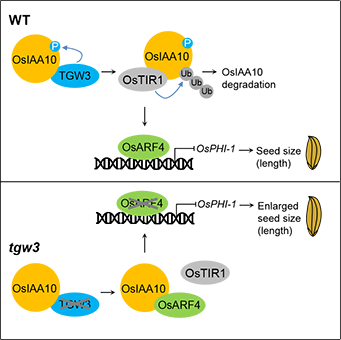
Figure. Phosphorylation of OsIAA10 caused by TGW3 shapes rice grain size through alteration of the auxin signaling regulatory module OsTIR1-OsIAA10-OsARF4
In a research work published in Cell Reports, Prof. SONG Xianjun's group from the Institute of Botany of Chinese Academy of Sciences revealed a gene network underlying the regulation of seed size: A genetically defined cascade OsTIR1-OsIAA10-OsARF4 plays an important role in controlling rice grain size, and TGW3 phosphorylation of OsIAA10 regulates the trait through alteration of the corresponding auxin signaling.
Together with those in other groups, the researchers in 2018 have reported a major QTL called TGW3 for grain size and yield, the target gene of which encodes a GSK3-like protein kinase. They next identified the canonical auxin/indole-3-acetic acid protein OsIAA10 as a new interacting partner of TGW3. As anticipated, TGW3 has the capability to phosphorylate OsIAA10. Interestingly, they identified three serine sites Ser68, Ser75, and Ser97 of OsIAA10 as the major amino acids that are phosphorylated by TGW3, and found that phosphorlation of OsIAA10 is involved in grain size regulation.
Furthermore, they revealed that TGW3 phosphorylation of OsIAA10 boosts the substrate’s ubiquitylation and proteolysis. Mechanistically, the OsIAA10 phosphorylation favors its interaction with OsTIR1 but hampers its association with OsARF4 (Figure). Furthermore, genetic evidence indicated that a viable auxin signaling axis OsTIR1-OsIAA10-OsARF4 regulates rice grain size. In addition, they suggested that TGW3 mediates BR response, and the physiological effect can be relayed through the regulatory pathway.
Overall, these findings uncover a phosphorylation-driven auxin signaling pathway for seed size regulation in rice that provides useful information for improvement of the agronomic trait in crops.